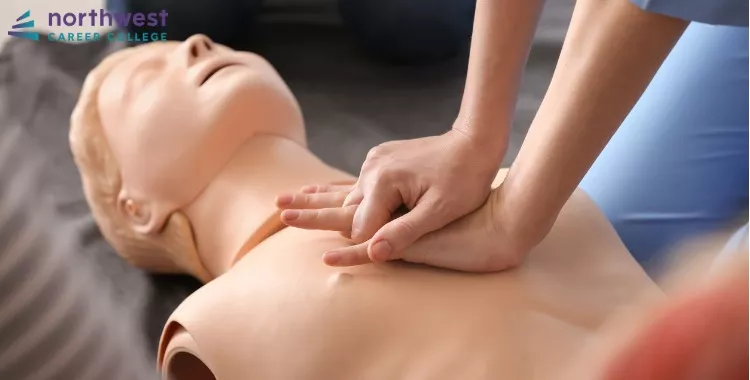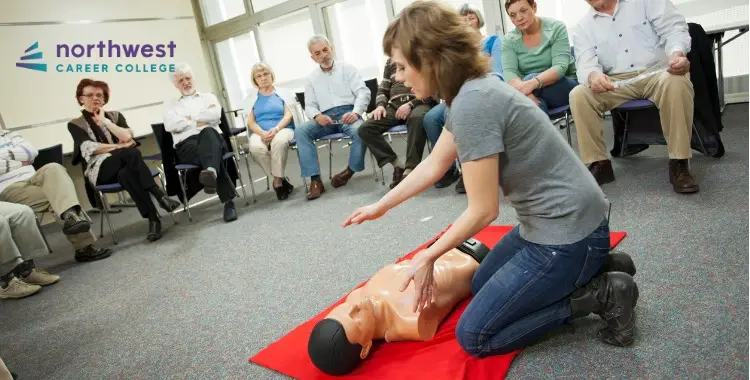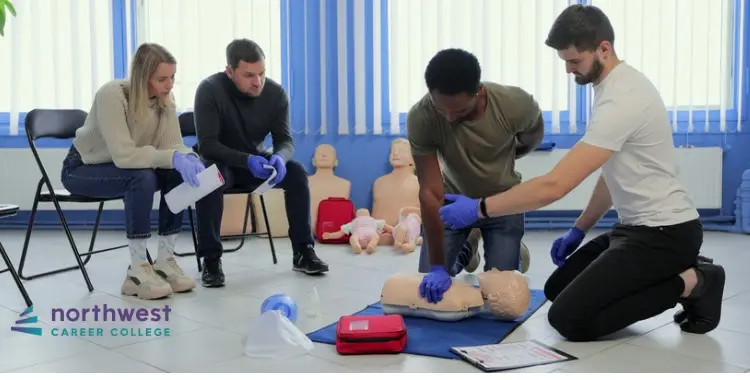A Guide to How CPR is Performed
- CPR
- March 12, 2024
- 12.7k views
- 7 min read

If you are a student interested in learning the basics of performing cardiopulmonary resuscitation (CPR), this post is for you. Understanding the importance of CPR and its steps can be a lifesaving skill – not just something taught in health classes.
This guide will guide you through understanding why CPR is necessary and how it’s correctly performed. It’s never too early to educate yourself on this essential medical procedure, which could help save someone’s life one day!
Table of Contents
- Understanding the Basics of CPR – What it is, when it’s Needed, and why you should learn it
- Preparing for CPR – How to set up a safe environment and gather the necessary materials
- Performing Chest Compressions – Step-by-step instructions on how to perform chest compressions effectively
- Performing Rescue Breaths – Guidelines on how to administer rescue breaths to revive the patient
- Knowing When to Stop – Tips on when it may be time to stop performing CPR and seek medical help.
- Learning More About CPR – Resources on where to go if you want to learn more about this life-saving technique
- Learn CPR today
Understanding the Basics of CPR – What it is, when it’s Needed, and why you should learn it
Learning CPR, or cardiopulmonary resuscitation, is a vital skill everyone should possess. It is an emergency procedure that can save the life of someone who has stopped breathing or has no heartbeat.
CPR involves pressing on the chest to keep blood flowing to the vital organs until medical help arrives. It’s needed in drowning, heart attacks, and accidents. By knowing how to perform CPR, you could be the difference between life and death for someone you love.
Learning CPR may seem daunting, but it’s not as difficult as you think. Enrolling in a CPR training course can teach you to react quickly and help save a life.
Preparing for CPR – How to set up a safe environment and gather the necessary materials
Preparing yourself to perform CPR can be crucial to saving a life in emergencies. First, ensure you’re in a safe environment by checking for hazards and clearing the area around the person.
Begin gathering the necessary materials, such as gloves, a CPR mask, and an AED if available. Take a deep breath and remember that you are doing everything possible to help the person in need.
With these preparations, you can help provide the best possible chance of survival for someone experiencing cardiac arrest. Remember, doing something is always better than doing nothing.
Performing Chest Compressions – Step-by-step instructions on how to perform chest compressions effectively
Performing chest compressions is a critical skill that can save lives in emergencies and involves the following steps:
- Begin by placing the person on their back on a firm surface.
- Position yourself kneeling beside the person’s chest and place the heel of one hand in the center of the chest, with the other on top.
- Interlock your fingers and, keeping your arms straight and elbows locked, press down hard and fast, compressing the chest about two inches.
- Repeat this rhythm, performing chest compressions 100-120 times per minute.
- It’s essential to keep the person’s airway open during contractions and allow the chest to recoil fully before performing the subsequent contraction.
With these steps, you can effectively perform chest compressions and potentially save someone’s life.
Performing Rescue Breaths – Guidelines on how to administer rescue breaths to revive the patient
Administering rescue breaths is a lifesaving skill that could be useful in emergencies.
When someone’s breathing has stopped or is shallow, performing rescue breaths is often the first step in resuscitation. Here are some guidelines to help you administer rescue breaths correctly.
- To begin with, ensure the patient’s airway is clear and check for any objects that might obstruct their breathing.
- Place one hand on their forehead to tilt their head back and the other under their chin to lift it forward.
- Pinch their nose and create an airtight seal over their mouth with your own.
- Blow into their mouth slowly and steadily for about one second, then watch their chest rise.
- Repeat this twice and check for signs of breathing.
- If there is still no breathing, seek medical help immediately.
Remember, knowing how to perform rescue breaths could mean the difference between life and death.
Knowing When to Stop – Tips on when it may be time to stop performing CPR and seek medical help.
Performing CPR can be a lifesaving measure, but knowing when to stop and seek medical help is essential. If the person does not respond after giving CPR for a few minutes, it may be time to call for emergency medical services.
Additionally, if you are too tired to continue performing CPR, handing the responsibility to someone else or waiting for help is essential. Another sign that it may be time to stop CPR is if the person’s pulse returns and they begin to breathe independently.
Seek medical help as soon as possible to give the person the best chance of recovery.
Learning More About CPR – Resources on where to go if you want to learn more about this life-saving technique
Learning CPR can differentiate between life and death in an emergency. Luckily, plenty of resources are available for those who want to improve their knowledge of this critical skill.
The American Red Cross and the American Heart Association offer comprehensive CPR courses for various situations, from basic CPR to CPR for healthcare professionals. Local community centers and hospitals may also offer classes, and online courses are available.
It’s important to remember that mastering CPR requires hands-on training and practice, so take advantage of any opportunities for in-person instruction. By learning more about CPR, you can better handle emergencies and potentially save a life.
Northwest Career College’s CPR Course is designed to equip students with the skills, knowledge, and resources to provide basic life support measures in an emergency.
The course covers recognizing signs of cardiac arrest, assessing breathing status, performing rescue breaths, using an AED (automated external defibrillator), learning proper hand placement during chest compressions, and more.
Students in the course will learn how to apply the most current American Heart Association (AHA) CPR Guidelines for adults, children, and infants.
Upon completing our CPR Course, students will receive an AHA certification card valid for two years from the issue date. Our instructors are highly experienced medical professionals who can offer valuable insights and tips to help you feel comfortable and confident responding to an emergency.
Contact us today to learn more about our CPR Course and how you can be prepared to save a life.
Learn CPR today
Knowing CPR could save a life one day. It’s important to know the proper steps to take in order to help someone who is not breathing. If you see someone who is not breathing, the first thing you should do is call 911 and then check their pulse.
If they don’t have a pulse, then you need to start chest compressions by pushing down on their chest at a rate of 100-120 compressions per minute. If the person starts coughing or vomiting, roll them onto their side so they don’t choke on their own vomit. Once the person starts breathing again or medical help arrives, continue checking their pulse and monitor their breathing until professional help arrives.
To learn more about CPR and how you can become certified, contact Northwest Career College today!
Learn To Save Lives Yourself
Here at Northwest Career College, we are committed to providing affordable, quality CPR Classes to the Las Vegas community.
We pride ourselves on being an American Heart Association (AHA) testing center and we offer Las Vegas CPR classes designed to fit your personal needs and professional schedule.
As part of our “student-focused” approach to education, we also offer our CPR classes free of charge to all of our students. Call us today at (702) 403-1592 to book your CPR class and become qualified to save a life in just four hours!




